The Agni series of strategic missiles were developed as part of Integrated Guided Missile Programme (IGDMP). The IGDMP was launched in 1983 to achieve self-sufficiency in missile capability, with simultaneous development of a wide range of missile: Nag, Prithvi, Akash, Trishul & Agni-Technology Demonstrator.
It envisaged common development and reuse of key technologies, and manufacturing facilities, ranging from propulsion system, aerodynamics, avionics, flight control, sensors and warhead.
The range of a missile determines the minimum speed that the rocket imparts on the RV. Longer range requires greater velocity. A launch velocity of 7.7 km/sec (relative to earth) is enough to insert the payload into low earth orbit, yet a full range ICBM that can reach furthest corner of earth (range 20,000 km) requires velocity of 7.5 km/sec.
The IGDMP missiles involved close end-user involvement in all phases, from weapon specifications to development. It is important to note that in 1983 military users had specific domain expertise in weapons systems related to their services, viz Air Force, Army and Navy.
At that time Strategic Forces Command (SFC) or Nuclear Command Authority (NCA) did not exist to take on the role of end-user. That role as we know now was played by a joint team of strategic thinkers, military technologist and select military officers. One can notice that strategic missiles are a different class not only in this aspect but also in the technology & system development aspects.
Strategic missiles have to blend with other key elements that make a complete strategic weapon system viz:
- Strategic policy organisation
- Strategic nuclear warhead
- Strategic missiles
- Precision navigation
- Command and control
India’s strategic weapons programme started in early 70′s with Project Devil (SRBM) and Project Valiant (ICBM). Project Valiant was an attempt to build 8,000 Km range missile. Valiant missile had three liquid fuel stages. The first stage consisting of cluster of four engines, each of 30 tonnes thrust, second stage of two 30 tonnes thrust engines and last stage with a single 30 tonnes thrust1. The missile lift off weight was about 85 tonnes. The 30 tonnes thrust liquid engine was first test fired on 10 May 1974, but soon thereafter the project was cancelled because of insufficient progress, weak programme management and organisation structure2.
Re-entry Vehicle (RV)
Unlike most other military weapons, long range ballistic missiles are designed and customised around the Re-entry Vehicle. Like other long range ballistic missiles Agni RV design is driven by the following vital specifications:
- Payload3 weight and shape
- Range
- Launch platform
Impact of Payload Mass on Rocket Weight
For a given maximum range the MTOW (Maximum Take off Weight) of missile is almost directly proportional to the payload weight. Reducing payload mass involves realising compact and small weapon. Equally important is realisation of light weight RV and other gear that ride the RV.
Smaller payload mass result in other overheads that limits the lowest missile mass. On the other hand, heavy payload mass (say for MIRV configuration) incurs the penalty of providing for a payload nose shield that must be carried up to an altitude of 90 km before it can be jettisoned.
Effect of Fabrication Technology on Weight
For a given range and payload the MTOW (Maximum Take-Off Weight) of missile is largely dependent on rocket motor’s MF (Mass Fraction) and number of motor stages. The fuel’s ISP (Specific Impulse) is also important, but all modern long range missile use solid fuel thus they have similar ISP.
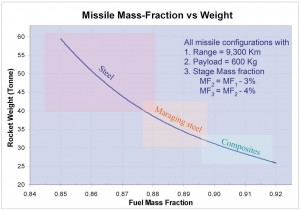 Indian solid fuel chemistry choice, however, has better growth potential compared to US fuel standardised for Space-Shuttle SRB (Solid Rocket Booster)4. Motor’s mass fraction is the single most important factor in determining the weight of missile, especially those designed for 8000 to 18,000 Km range.A case to the point is the recently tested French M51 submarine launched missile5. The 56 tonne M51 has 3 stage and all three motor case are made of carbon-carbon fiber composite material to maximise the fuel mass fraction so the missile can fit into current launch tube of French nuclear submarines6 carrying the M41 missile, yet it carries 50% more payload over 50% more range.The M51 missile’s range is 9,000 km for 6 MIRV payload (1,400 kg including penetration aid). Yet the same missile delivers full ICBM range (20,000 km) for a configuration with fewer (2) MIRVs providing flexibility to France.
Indian solid fuel chemistry choice, however, has better growth potential compared to US fuel standardised for Space-Shuttle SRB (Solid Rocket Booster)4. Motor’s mass fraction is the single most important factor in determining the weight of missile, especially those designed for 8000 to 18,000 Km range.A case to the point is the recently tested French M51 submarine launched missile5. The 56 tonne M51 has 3 stage and all three motor case are made of carbon-carbon fiber composite material to maximise the fuel mass fraction so the missile can fit into current launch tube of French nuclear submarines6 carrying the M41 missile, yet it carries 50% more payload over 50% more range.The M51 missile’s range is 9,000 km for 6 MIRV payload (1,400 kg including penetration aid). Yet the same missile delivers full ICBM range (20,000 km) for a configuration with fewer (2) MIRVs providing flexibility to France.
Impact of Payload Mass on Rocket Range
As can be expected the missile range increases for lighter payload. For lighter payload the range in particular is affected by the fuel Mass-Faction (MF) of the last stage.
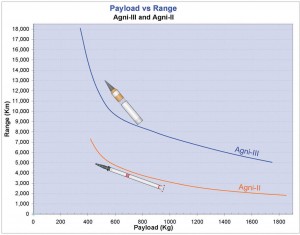 The range for a set MTOW and fabrication technology is dramatically improved if the missile is partitioned into 3 stages. Increased number of stages does impact cost and reliability but its long range performance is much superior for reduced throw-weight configuration.Agni Re-entry vehicle evolved over 3 phases:
The range for a set MTOW and fabrication technology is dramatically improved if the missile is partitioned into 3 stages. Increased number of stages does impact cost and reliability but its long range performance is much superior for reduced throw-weight configuration.Agni Re-entry vehicle evolved over 3 phases:
- Concept evaluation
- RV for Agni-TD, Agni-II, Agni-I
- RV for Agni-III
Concept Evaluation of RV for Strategic Ballistic Missile
In mid-1980’s world’s contemporary strategic weapons development centered around weapon design of between 150-400 Kt yield, instead of Megaton yield that was the norm in 1960’s and 70’s. The Megaton yield of earlier nuclear age was necessary to account for and compensate for poor missile accuracy. Over period of time missile accuracy improved and the same effectiveness could be achieved with lighter and lower yield (150-300Kt) weapons. Lighter weapons also allowed many weapons to be launched on a missile (MIRV).
MIRV evolved from multiple satellite launch programme of civilian space agency7. MIRV greatly improved effective use of nuclear weapons in both counter-force as well as counter-value strike role. For identical net yield, the damage from many smaller yield weapons that are well spread out is many times more compared to a megaton yield weapon8. The era of 1970’s and early 80’s was that of MAD (Mutually Assured Destruction), but technological improvement in 80’s enabled nuclear war-fighting doctrines, i.e. counter-force nuclear weapon application, culminating in development of smaller yield battlefield nuclear weapons including enhanced radiation weapon.
India tested a pure fission nuclear explosive on 18 May, 1974. In 1975 BARC started developing a miniaturised design using fusion boosted fission, and military grade triggers9. By early 1980s BARC had confidence to make robust 200 Kt yield weapon using boosted fission design.
In 1987 IGDMP first envisaged developing a re-entry vehicle that was “designed for 100-250 Kg payload at speed of 7-8 km/sec”10 clearly corresponding to a light weight medium yield fission-weapon & ICBM range11. But strategic requirement also required high yield weapons (about 200 Kt yield) that impose bigger space and weight requirements. After more reviews and debates, the RV was designed for bigger payloads to match BARC’s high yield weapon. BARC’s contemporary 200 Kt boosted fission weapon designed for the purpose weighed about 1000 Kg, that defined REX12 (RV-MK.1) on Agni-TD and later used on Agni-II and Agni-I. IGDMP Director Dr APJ Kalam later said that they evaluated 180 different Agni configurations before settling on the final choice.
The 1000 kg payload mass was also compatible with conventional weapon payload making the missile useful in non-strategic role.
Effect of Range and Payload Mass on RV
The range of a missile determines the minimum speed that the rocket imparts on the RV. Longer range requires greater velocity. A launch velocity of 7.7 km/sec (relative to earth) is enough to insert the payload into low earth orbit, yet a full range ICBM that can reach furthest corner of earth (range 20,000 km) requires velocity of 7.5 km/sec.
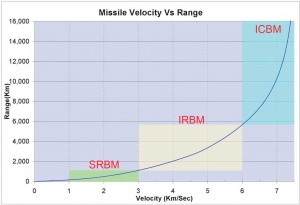 The kinetic energy builds up as square of the velocity, thus when payload re-enters the atmosphere at hypersonic velocity the RV encounters shockwave and supersonic drag that varies along the altitude. It encounters extreme temperature régime (about 3,000ºC) followed by extreme deceleration régime; corresponding to energy dissipation in excess of 100 Megawatt that can easily destroy anything but the toughest re-entry vehicle.Understandably ICBM RV undergoes the worst environment.
The kinetic energy builds up as square of the velocity, thus when payload re-enters the atmosphere at hypersonic velocity the RV encounters shockwave and supersonic drag that varies along the altitude. It encounters extreme temperature régime (about 3,000ºC) followed by extreme deceleration régime; corresponding to energy dissipation in excess of 100 Megawatt that can easily destroy anything but the toughest re-entry vehicle.Understandably ICBM RV undergoes the worst environment.
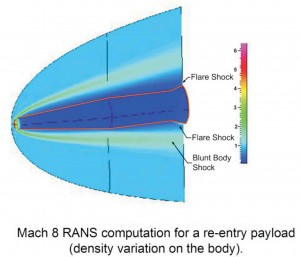 During re-entry the missile encounters extremely high temperature as the atmosphere tries to retard the speed of RV traveling at hypersonic speed.The high temperature can vaporise all known material and the only way to reduce the temperature is to spread the heat flux across a larger RV area and using an ablative material to form a blunt leading edge (typically a semi-hemispherical shaped body made of carbon-carbon reinforced composites).
During re-entry the missile encounters extremely high temperature as the atmosphere tries to retard the speed of RV traveling at hypersonic speed.The high temperature can vaporise all known material and the only way to reduce the temperature is to spread the heat flux across a larger RV area and using an ablative material to form a blunt leading edge (typically a semi-hemispherical shaped body made of carbon-carbon reinforced composites).
As the missile descends further the atmosphere density increases and the drag rapidly rises, also a very strong shockwave builds at the leading edge increasing the local tip temperature well beyond 3,000º C.
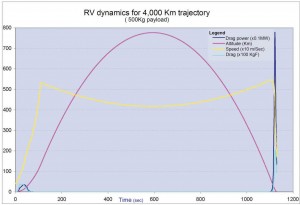 Tremendous dynamic pressure builds along the RV body creating drag that dissipates kinetic energy at the rate of 30 – 220 megawatt.
Tremendous dynamic pressure builds along the RV body creating drag that dissipates kinetic energy at the rate of 30 – 220 megawatt.
Eventually the RV enters ‘MaxQ’ point where the dynamic pressure is maximum. This combination of extremely high temperature and dynamic pressure can easily wreck anything but a most carefully engineered system using a combination of exotic material and manufacturing process.
Agni-TD (Technology Demonstrator)
The Agni-TD’s RV-Mk.1 nose tip is made of a multi-directionally woven, reinforced carbon-carbon fiber composite material. The 0.8 metre diameter (1.0 m flare skirt) and ~4 metre long, reentry vehicle consists of five sections. Each of these sections is made up of a two-layer composite construction. The inner layer is made up of carbon/epoxy filament mould constructed on a CNC winding machine and is designed to withstand structural loads. The outer layer is ablative and made of carbon/phenolic filament wound construction.
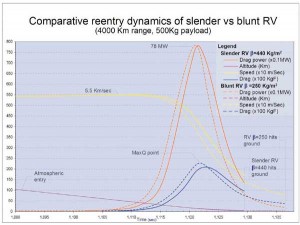 This 1980-circa RV (Figure 8-C) was designed to carry BARC-developed 1980 circa, boosted nuclear weapon of 200 kT yield weighing ~1,000 kg (Figure 3, Figure 8-A). The 80 cm body diameter is determined by the diameter of the boosted fission weapon. RV’s blunt nose tip of 30 cm spherical diameter and 14.3º cone angle indicates use of moderately high beta (²)14 design for ICBM class high reentry velocity yet modest temperature stress (3,000°C). The 1,000 kg RV sees peak power dissipation in excess of 120 megawatts (Figure 7: Effect of ‘²’ on RV stress).
This 1980-circa RV (Figure 8-C) was designed to carry BARC-developed 1980 circa, boosted nuclear weapon of 200 kT yield weighing ~1,000 kg (Figure 3, Figure 8-A). The 80 cm body diameter is determined by the diameter of the boosted fission weapon. RV’s blunt nose tip of 30 cm spherical diameter and 14.3º cone angle indicates use of moderately high beta (²)14 design for ICBM class high reentry velocity yet modest temperature stress (3,000°C). The 1,000 kg RV sees peak power dissipation in excess of 120 megawatts (Figure 7: Effect of ‘²’ on RV stress).
Agni-TD was first launched on 22 May, 1989 to prove the RV-Mk.1. The re-entry vehicle was designed to ensure that the temperature inside the vehicle does not exceed 60° celsius, a condition necessary to protect the warhead and electronic systems placed inside. During tests, the re-entry vehicle technology was fully proved when the nose-cone withstood temperatures of 3,000°C while the inside temperature was only 30°C15. It is important to note that re-entry temperature peak is independent of the payload weight. Thus the Agni-TD with the RV fitted with a high altitude motor could achieve necessary test velocity, to fully qualify the re-entry regime.
The RV housed an integrated High Altitude Motor (HAM). The liquid fuelled HAM is used to correct impulse variance of solid fuelled stages and subtle launch trajectory variance; approximately 50 to 80 kg fuel is estimated to be sufficient. There are indications that the RV is intended to enter a gliding trajectory when it enters atmosphere at an altitude of 100 km, this further reduces thermal stress.
Arrival of Modern Thermonuclear Weapon: Pokhran-II
In response to changed security environmentIndia conducted Shakti series of nuclear weapon tests16 on 11 & 13 May, 1998. Shakti-1 (Figure 8-A) was a two stage Thermonuclear (TN) bomb (of modern 1995 design vintage) with a passive third stage made of non-fissionable material. It should be noted that in a Thermonuclear weapon the third stage provides around 80% of the yield from fast fission of U238 by fast neutrons generated by fusion stage17.
Fast fission of U238 (or U235) is a basic material property that does not require testing in weaponised configuration. Shakti-1 did not have a third stage to keep the yield within test-shaft capability (venting) and test site constrains (seismic damage to inhabited villages nearby). The Shakti-1 based Indian TN weapon yield is 200-300 Kt depending on if tamper and case material is made of natural-uranium (U238) or enriched-uranium18. The new 200 Kt TN weapon (Figure 3-B) is much lighter than the earlier 1,000 Kg Boosted Fission weapon (Figure 3-A) that was the basis for earlier RV-Mk.1 design. Fission weapons are dense and spherical in shape, whereas TN weapons have lower density and elongated in shape yet very high yield to weight ratio. The 200 Kt yield TN weapon reportedly weighs less than 450 Kg, however other sources indicate less than 300 Kg weight, yet few other sources indicate a figure as low as 200 Kg19.
Interestingly the 200 Kt boosted fission design that was the basis for Agni-TD and RV-Mk.1 design was not even tested in Shakti-series of nuclear weapon tests in 1998. For best performance the 200 Kt TN payload requires its own custom RV design and rocket stages but that would have to wait for many years.
The 1999 ‘Kargil war’ forced DRDO to improvise and quickly develop and operationalise Agni-II missile that used the new light weight TN weapon albeit using the old RV-Mk.1 that was designed and optimised for heavier 1,000 Kg boosted fission payload. This can be deduced from the pictures of the Agni-II & Agni-I released by DRDO.
Agni-II and Agni-I Maneuvering Re-entry Vehicle: MRV-Mk.2
This RV largely inherits the basic structure, design and technology of the earlier Mk.1 RV of the Agni-TD, but has more functionality and superior performance. After making room for new and lighter Indian thermonuclear weapon payload, the RV has room for about 200 kg liquid fuel in pressurised vessels to serve as High Altitude Motor for propulsion, as well as velocity correction.
It is interesting to note that long-range missiles developed by other countries use RVs that are passive ballistic mass, thus their accuracy depends on ability of missiles RV-bus to place RV on precise ballistic trajectory. The Agni-RV Mk.2 on the other hand, is more advanced because it embodies propulsion, navigation and control all the way to the target.
At least one variant uses a set of solid fuelled impulse cartridges for velocity trimming. The less than perfect mating of lightweight TN weapon an RV designed for heavier 1,000 Kg payload imposed its own challenges (different CG and lowered ‘²’ due to lighter payload) that also required addition of aero-fins.
The lowered ‘²’ more rapidly slows the RV makes it susceptible to atmospheric disturbances and interception. On the other hand, reduced payload mass significantly increased the missile velocity & range (see range graph in Figure 2).
The RV has an attitude control system and aerodynamic maneuver fins, for better control, accuracy and survivability. Unconfirmed reports suggest that an improved optical or radar terminal phase correlation system has been developed to provide accuracy of around 40 metres CEP.
It is interesting to note that long-range missiles developed by other countries use RVs that are passive ballistic mass, thus their accuracy depends on ability of missile’s RV-bus to place RV on precise ballistic trajectory. The Agni-RV Mk.2 on the other hand, is more advanced because it embodies propulsion, navigation and control all the way to the target.
Recent ICBM Developments
Last few months saw maiden test flights of two new generation ICBMs. The Indian Agni-III (9 July, 2006) and the French M51 (9 Nov, 2006) made by DRDO and EADS-SPACE respectively.
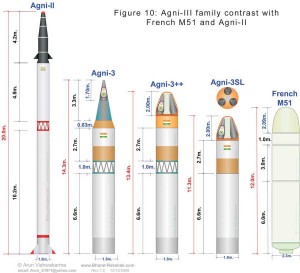 The M51 is a 3 stage missile that is 12m long and 2.3m diameter (Figure 10). All 3 stages have flex nozzle (for thrust vectoring) and the case made of wound carbon-epoxy fiber composite21 to maximise the fuel mass fraction such that the missile can fit into the missile launch tube of French SNLE nuclear powered ballistic missile submarine carrying the M41 missile, yet it carries 50% more fuel to provide 50% more payload and 50% more range.
The M51 is a 3 stage missile that is 12m long and 2.3m diameter (Figure 10). All 3 stages have flex nozzle (for thrust vectoring) and the case made of wound carbon-epoxy fiber composite21 to maximise the fuel mass fraction such that the missile can fit into the missile launch tube of French SNLE nuclear powered ballistic missile submarine carrying the M41 missile, yet it carries 50% more fuel to provide 50% more payload and 50% more range.
The solid fuel motors are very heavily packed to carry the additional fuel mass (almost 85% of available internal volume). The 56 tonnes missile’s declared range is 8000 km for 6 MIRV payloads and penetration aids totaling 1,400 kg. Yet the same missile delivers high ICBM range (16,000 km) for a configuration with fewer (2) MIRVs thus providing flexibility to France nuclear doctrine.
DRDO’s Agni-III is a 2 stage missile that is 14.3m long and 1.8 metre22 diameter (Figure 10). Both stages have flex nozzle for optimal flight and trajectory control. The motor case are made of wound carbon fiber composite material23 for high fuel mass fraction that is necessary for a small but long range missile. The first and second stages are about 6.6 metres and 2.7 metres long with a 1 metre vented inter-stage24.
The missile supports a wide range of warhead configurations, with total payload ranging from 600 kg to 1,800 kg. The missile is compact and small enough for easy mobility and flexible deployment on different types of surface and sub-surface platforms. The diameter is compatible with a recently tested Indian sub-surface launch system with 2.4 metre diameter launch tube25. The Agni-III is clearly a precursor to a submarine launched version (Agni-3SL in Figure 10).
Agni-III Re-entry Vehicle Options
Finally, the suboptimal RV gave way to a new RV custom designed & optimised for the newer and lighter 200 Kt TN payload weapon and capable of very high speed reentry. The RV-Mk.4 (Figure 8-E & F) (estimated from news reports, analysis and trade practices) has the following significant features:
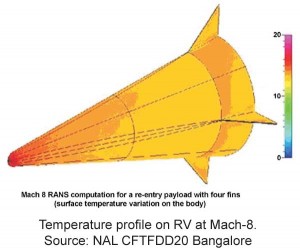 An all carbon composite RV that uses no metal backup (world’s first)26. This light and tough RV enables large increase in range for light payload.
An all carbon composite RV that uses no metal backup (world’s first)26. This light and tough RV enables large increase in range for light payload.
The high ‘²’ ( ² = m * CD / A ) RV design with 17 cm diameter blunt nose27 to generate a separating shock wave to keep the thermal flux away from the RV body.
The RV is 1.7 metre long and cone angle of 20° with maximum body diameter of approx 0.6m. Thus the effective body area is at least half that of RV Mk-2. The ‘²’ is high in spite of lighter mass.
Strong, full skin high temperature rating, high ‘²’ design. The new lightweight composites can withstand temperatures of up to 5,000º centigrade thus its cone angle is more aggressive (Figure 8-G), yet capable of all re-entry velocities.
The RV has been flight tested before maiden flight of Agni-III28.
RV-Mk.3 (Agni-3)
To test Agni-III with single new warhead requires a bigger RV body that can adapt with the large diameter motor. Compared to Agni-II this RV is shorter, more voluminous and 3.3 metre long.
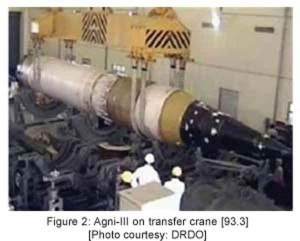 The large base diameter makes it unviable for high speed re-entry, thus this could be a payload adapter section that jettisons the real RV located in the front section. The high ‘²’ RV in combination with an all carbon composite body enables higher re-entry speed even with a light weight payload29.
The large base diameter makes it unviable for high speed re-entry, thus this could be a payload adapter section that jettisons the real RV located in the front section. The high ‘²’ RV in combination with an all carbon composite body enables higher re-entry speed even with a light weight payload29.
RV-Mk.4 (Agni-3++ & Agni-3SL)
This small RV allows compact MIRV configuration atop the Agni-III (Figure 8-F & Figure 10) reducing the missile length to bare minimum. Upto 3 MIRV’s (mounted inclined to reduce the overall height) can be accommodated in the nose with a protective nose cone that is jettisoned at ~90Km altitude.
A3 stage configuration Agni-3++ with the addition of a short third stage increases the range very significantly particularly with fewer MIRVs.
Enhancing the basic two stage design to eliminate the 1metre interstage, the Agni-3SL configuration (Figure 10) is short enough to make its way to submarine deployment. At 11.3 metre the overall missile length is submarine compatible and smaller than French M51.
Conclusion
One can see from above that Indian ballistic missile programme has steadily and methodically progressed to provide an affordable yet robust strategic deterrence commensurate with its national needs. With Agni-III the nuclear triad will be truly complete. The missile can be dispersed far and wide in the Indian mainland, it’s far flung islands or it’s blue water naval assets dispersed across the world’s oceans. The ability to reach all corners of a potential challenger, with MIRV and flexible range of between 5,000 to 16,000 km.
Sources & References
- “Evaluating India’s land-based Missile Deterrent”. Indian Defence Review Vol-19(4) Oct-Dec 2004, ISSN 0970-2512, Arun Vishwakarma, Dr Sanjay Badri Maharaj. Lancer Publishers & Distributors, New Delhi.
- “Weapons of Peace: The Secret Story of India’s Quest to be a Nuclear Power” - Raj Chengappa (New Delhi: Harper Collins Publishers India, 2000, ISBN 81-7223-332-0).
- Defence Research & Development Organisation (www.drdo.com)
- DRDO periodicals “Technology Focus” bi-weekly (www.drdo.com/pub/techfocus/welcome3.htm)
- Indian Defence Technology: Missile Systems (DRDO, Ministry of Defence, December 1998).
- Nuclear Threat Initiative (www.nti.org)
- “Ballistic Missiles and Missile Defence in Asia” NBR Analysis, VOLUME 13, NUMBER 3, JUNE 2002. (www.eurasia.nbr.org/publications/analysis/pdf/vol13no3.pdf)
- “Agni-III Long Range Missile”, Indian Defence Review Vol-21 (2) Apr-Jun 2006, ISSN 0970-2512, Arun Vishwakarma. Lancer Publishers & Distributors, New Delhi.
- “A study of the Motion and Aerodynamic Heating of Ballistic Missiles entering the Earth’s Atmosphere at High Supersonic Speeds”. Report 1381- National Advisory Committee for Aeronautics.
- Nuclear Weapon Archive, ‘India’s Nuclear Weapons Programme: Present Capabilities’http://nuclearweaponarchive.org/India/IndiaArsenal.html
Notes
- Weapons of Peace: The Secret Story of India’s Quest to be a Nuclear Power - Raj Chengappa (New Delhi: Harper Collins Publishers India 2000, ISBN 81-7223-332-0)
- ibid. Also http://www.nti.org/e_research/profiles/India/Missile/index.html
- Payload defined as consisting of the weapon, re-entry vehicle, and supporting electro mechanical and avionics sub-systems.
- Discussion with a former space scientist in Bangalore.
- M51 missile can carry 6 MIRV (TN75 of 100kT yield) beyond 8000 Km.
- French SSBN ‘Le Triomphant’ submarines are fitted with 16 SLBM launch tubes. The first boats will carry the improved M-45 variant SLBM, until the M-51 becomes available in 2010.
- ‘The United States used NASA’s experience in guiding the Titan II transtage, a “bus” designed for multiple satellite launchings, to develop a bus that would accurately deliver small nuclear warheads’. Ted Greenwood, Qualitative Improvements in Offensive Strategic Arms: The Case of the MARV (Cambridge: Center for International Studies, Massachusetts Institute of Technology, Aug. 1973), p. 278.
- The advantage of a MRV versus a single warhead is that the damage produced in the center of the pattern is far greater than the damage possible from any single warhead in the MRV cluster, this makes for an efficient area attack weapon.http://en.wikipedia.org/wiki/Multiple_Reentry_vehicle
- Weapons of Peace: The Secret Story of India’s Quest to be a Nuclear Power - Raj Chengappa (ISBN 81-7223-332-0) Pg 207: 1975 BARC’s M Srinivasan headed the fusion boosted fission bomb. And also Li Ti based trigger. Iyengar said team worked on miniaturising the bomb with flying plate technique.
- ASL: ‘From long-range missiles to lightweight callipers’ M Somasekhar Business Line, THE HINDU Jul 25, 2005 http://www.thehindubusinessline.com/2005/07/25/stories/2005072501331400.htm
- ICBM reaches very high final velocity ranging from 7-8Km/sec. At 8Km/sec final velocity the rocket is capable of placing the payload in low earth orbit thus capable of staying in orbit for many days.
- REX Re-entry experiment was the most important technology development objective of Agni-TD project. “Weapons of Peace: The Secret Story of India’s Quest to be a Nuclear Power” - Raj Chengappa (ISBN 81-7223-332-0) NAL: Computational and Theoretical Fluid Dynamics Division http://www.nal.res.in/oldhome/pages/divcfd.htm#pub
- The ballistic coefficient ‘²’ is a measurement of an object’s ability to move through a fluid. It takes into account the effects of an object’s density and its skin friction, and is calculated as follows: ² = m * CD / A
- Weapons of Peace: The Secret Story of India’s Quest to be a Nuclear Power - Raj Chengappa (ISBN 81-7223-332-0)
- The May 1998 Pokhran Tests: Scientific Aspects, by R. Chidambaram.http://www.saag.org/papers5/paper451.html
- “Teller-Ulam” Summary : Basic Principles of Staged Radiation Implosion. http://nuclearweaponarchive.org/Library/Teller.html
- U235’s fissile cross section for fast neutron emanating from the fusion stage is about twice that of Natural Uranium.
- “Measurement of neutron-induced fission cross-sections of Th232, U238, U233 and Np237relative to U235 from 1 MeV to 200 MeV”, Oleg A. SHCHERBAKOV1), Alexander V. FOMICHEV2), Andrei Yu. DONETS2), Alexander B. LAPTEV1), Oleg I. SETROV2),Guennadii A. PETROV1) http://wwwndc.tokai-sc.jaea.go.jp/reports/rv98020/shcherbakov_p4.pdf
- India Cancels Agni III Test, UPI-Washington, May 31, 2006, “The Agni III is said to be able to deliver a 440-pound to 550-pound warhead with a high degree of accuracy.”http://www.spacewar.com/reports/India_Cancels_Agni_III_Test.html
- NAL: Computational and Theoretical Fluid Dynamics Division http://www.nal.res.in/oldhome/pages/divcfd.htm#pub
- French Submarine-Launched Ballistic Missiles programmes. http://www.space.eads.net/press-center/press-documents/456-en
- There are some indications that its diameter may be 2 metre or a little more.
- Composites: Use in saucepan handles, artificial limbs and the Agni missile: Current Science, Vol. 86, No. 3, 10 February, 2004
- Although Agni-III was test fired on 9 July, 6 there is no officially published description of its physical characteristics and performance. This paper has evaluated various press reports and used trade tools and materials to reverse engineer its physical characteristics and performance. There is, however, certain missile parametres that are confidential in nature that may never be announced but one can bound its lower and upper limit. This paper is reporting the median parametre values.
- Launching platforms for Project K-15. http://www.drdo.com/pub/techfocus/aug04/missile13.htm
- Composites: use in saucepan handles, artificial limbs and the Agni missile: Current Science, Vol. 86, No. 3, 10 February, 2004
- Photo evidence to estimate dimension.
- A success story TS Subramanian Frontline Volume 22 - Issue 20, Sep 24-Oct 7, 2005. http://www.hinduonnet.com/fline/fl2220/stories/20051007002009200.htm
- Light weight payload was an issue in earlier RV design. The older RV-Mk.2 with its blunt nose is an all range RV, however, for lighter payload its ² relatively low, thus slowing down the RV at the fag end of its trajectory




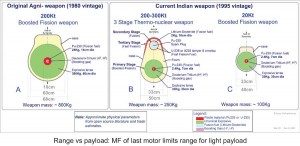


Is making a deal of Dassault Rafale by the IAF be going to be of any use in coming task , beacause most of the nations that are posing a threat on India are making even advanced fighter air-crafts ( like J-20 by CHINA).As the time is passing by, the deal is getting even costlier (and meaningless)? Although these air-crafts are going to complement the proposed FGFA and AMCA air-crafts, still spending that amount of money on such a plan that cannot prove to be decisive in a war in out of clue to understand.And at this time when India needs these fighter planes (right now), the deal is still under consideration and all the responsibility of defending Indian skies lies directly on Su-30 MKI (& also on old MIG-29 flanker). http://www.techinvicto.com/
Deterrence is necessary to zero out a resolute enemy’s thought of complete annihilation.
At the same time conventional weapons are to punish enemy in sub-nuclear engagement. Tejas is seed of our IAF backbone. SU30MKI is expensive to operate & maintain. Albeit good aircraft.
-Arun S Vishwakarma
Sir,
You wrote an eye opening article & gave us the clear view about our choice of materials as well as principles we are adopting to built nuclear weapons and missiles. I read lot of articles full with irrelevant content they were merely stories.
Namastey,
Glad to know you like it.
I encourage you (and all readers) to contribute materially to serve Bharat Maata in substantial ways.
Jai Bharat
-Arun S Vishwakarma
Sir,i have read yours articles time and again they give me immense confidence and at the same time reverence for you i have tried to look for an autopsy by you of Pak nuclear arsenal but have not found it could you please write a artic le about them
Namastey,
Happy to know you like it.
Please serve Bharat Maata in substantial ways.
Paki weapons are inconsequential. So I wont spend time on their nuke facade.
Here is a accurate rendering of their nukes, made by a friend of mine many years ago. Funny but accurate .
Photochor: AQ Khan
https://www.youtube.com/watch?v=wciSG_3-x28
Jai Bharat
-Arun S Vishwakarma
Read more at:
https://www.indiandefencereview.com/spotlights/indias-strategic-missiles/